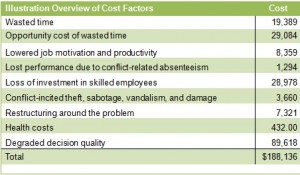Published on
Workplace Conflict, Bullying And Discordant Behavior: Impacting A Company’s Financial Resources
It took us just over 10 years to have Workplace Harassment legislation mandated here in Ontario in the Occupational Health and Safety Act. It took many people to be involved over those years to lobby parliament and grow public support to have it pass in December 2009. I would like to thank everyone that put in their time and energy to help create this historical piece of legislation.
Also, I would like to thank those who now are making it their goal through their work and own efforts to create healthy and safe harassment free workplaces. It may take a long time to create a change in social conscience and behavior; however this is what will pave the road to social change for the next generations.
It is my goal to leave our workplaces to be healthier and more cognitively enriching places to spend ones time.
Today, I am so glad to see on the internet, LinkedIn, in the workplace, the newspapers and people on the street are so engaged in the discussion of workplace conflict and harassment. It may not be removing it totally from the workplace, but it sure has it’s place firmly on the board room table.
One question often asked is how you calculate the cost of conflict in the workplace.
When I was trying to figure out how to start opening up this discussion to CEOs and CFOs when I did my own research back in the early 2000 to learn Business Leaders Perceptions on Workplace Bullying, I knew that a sure in would be highlighting the dollar cost to the business. Through my research I found Dan Dana, who had developed a Cost Calculator.
Let’s use Dan Dana’s Nine Cost Factors to simplify the process and break it down into manageable items. This will help you to walk away with understanding how it financially impacts a business, and you can directly apply this to your own workplace situations.
Dan Dana’s work shares nine factors businesses should be aware of when reviewing human resource conflict cost.
Nine Factors of Conflict:
Each factor has a formula to calculate the value of each in a conflict situation. After using the formula to calculate each factor you then add each factor to obtain a total sum for your conflict situation.
The above chart illustrates how Dan Dana’s nine factors of conflict begin to financially roll out. Now let’s break down this example from the real workplace and work through the actual incident.
This is a case from my observation research:
This is very simple go to http://www.mediationworks.com and request for the The Dana Measure of Financial Cost of Organizational Conflict I have copied and pasted the real incident results so you can have a look at the instrument in action on a real case. I would like to thank Dan Dana for all his work and his team also.
Instructions
Think of one particular conflict in your workplace that you know very well, perhaps one that you are or have been personally involved in. Keep that specific conflict scenario steadily in mind as you enter the variables in the calculator.
Enter your numeric estimates in the boxes below. For currency variables, you may enter values in US dollars, Canadian dollars, Euros, or any other currency.
Enter numeric values as whole numbers (no decimals). Do not use commas or other non-numeric characters.
It is recommended that you enter conservative estimates. Inflating or exaggerating these variables is not necessary to produce disquieting awareness of the financial resources currently being wasted by preventable organizational conflict.
Data Entry Section
Regarding the hourly employees involved in the conflict: (If none, scroll down for “professional and managerial” employees.)
| 6 | Number of individuals. Calculations assume full-time employment. |
| 10 | Average number of hours per week each individual spends involved in unproductive participation in conflict, including time distracted from productive work by thinking about or worrying about the conflict. |
| $34,498 |
Average annual wage of the hourly individuals involved in the conflict |
| 50% |
Estimate (as a percentage) of reduction in employees’ job motivation, enthusiasm, and company loyalty resulting from the unresolved conflict |
| 3 | Number of unscheduled personal days taken off work by the individuals involved during the period of conflict. |
| 1 | Were any decisions affecting the business made by any of the hourly employees that may have been influenced by the conflict? (Yes = “1”, No = “0”) |
| 0 | Number of hourly employees who were involuntarily terminated, at least in part due to the conflict. Enter zero (the numeral “0”) if none. |
| 1 | Number of hourly employees who voluntarily terminated their employment during or shortly following the period of conflict. Enter zero (the numeral “0”) if none. |
Regarding the professional and/or managerial employees involved in the conflict:
| 2 | Number of individuals. Calculations assume full-time employment. |
| 3 | Average number of hours per week each individual spends involved in unproductive participation in conflict, including time distracted from productive work by thinking about or worrying about the conflict. |
| $55,120 |
Average annual salary of the professional/managerial employees involved in the conflict |
| 10% |
Estimate of reduction (as a percentage) in employees’ job motivation, enthusiasm, and company loyalty resulting from the unresolved conflict |
| 0 | Number of unscheduled personal days taken off work by the individuals involved during the period of conflict. |
| 1 | Were any decisions affecting the business made by any of the professional/managerial employees that may have been influenced by the conflict? (Yes = “1”, No = “0”) |
| 0 | Number of professional/managerial employees who were involuntarily terminated, at least in part due to the conflict. Enter zero (the numeral “0”) if none. |
| 0 | Number of professional/managerial employees who voluntarily terminated their employment during or shortly following the period of conflict. Enter zero (the numeral “0”) if none. |
Other variables regarding the conflict:
| 12 | Duration of the conflict in weeks per year (minimum 1, maximum 52) – REQUIRED FIELD |
| 1 | Were work flow, job design, reporting relationships, or other otherwise unnecessary structural changes made to accommodate the individuals in conflict? (Yes = “1”, No = “0”) |
Default values: The following default values are based on cited published research, known industry averages, or other reliable sources. These values may be altered by the respondent if known to vary from default values. However, unless the respondent’s knowledge is certain, it is recommended that these default values be retained.
| 40 | Length of ordinary work week, in hours |
| 240 | Number of working days per year, considering holidays and two-week annual vacation. |
| 40% |
Incremental cost (as a percentage) of fringe benefits over base wage of hourly employees |
| 40% |
Incremental cost of (as a percentage) fringe benefits over base salary of professional/managerial employees |
| 75% |
Cost of replacing an hourly employee as percentage of annual compensation |
| 150% |
Cost of replacing a professional/managerial employee as percentage of annual compensation |
| 60% |
Percentage impact of unresolved conflict on decision to terminate employment voluntarily |
| 90% |
Percentage impact of unresolved conflict on decision to terminate employment involuntarily |
| 250% |
ROI (return on investment) of employer’s investment in labor |
| 2% |
Cost of conflict-incited theft, sabotage, and equipment damage by employees as a percentage of their expected contribution to corporate profitability. |
| 10% |
Cost in inefficiency of work flow resulting from otherwise unnecessary restructuring as a percentage of combined salaries/wages of employees in conflict. |
| 2% |
Increased cost of health insurance premiums and other health care-related expenses to the employer as a result of stress-related (psychogenic) illnesses and accidents as a percentage of combined salaries/wages of employees in conflict. |
| $900 |
Employer’s monthly cost of employee health plan. |
Then you submit the form.
Results
Displayed below are the resultant calculations of the financial cost associated with each of nine cost factors, as well as the total cost of the particular conflict that you used for reference. For your future reference, print this page using the “Print” feature of your browser.
Note that costs associated with litigation or negotiated settlements are not included in these calculations. Once a workplace dispute escalates to the level that legal services are involved, the costs rise dramatically. The Dana Measure is designed to estimate the financial cost of workplace conflicts before they escalate.
| Cost Factor | Cost |
| #1: Wasted time | 19,389 |
| #2: Opportunity cost of wasted time | 29,084 |
| #3: Lowered job motivation and productivity | 8,359 |
| #4: Lost performance due to conflict-related absenteeism | 1,294 |
| #5: Loss of investment in skilled employees | 28,978 |
| #6: Conflict-incited theft, sabotage, vandalism, and damage | 3,660 |
| #7: Restructuring around the problem | 7,321 |
| #8: Health costs | 432.00 |
| #9: Degraded decision quality | 89,618 |
| TOTAL COST of this conflict: |
$ 188,136 |
In the above incident we had an individual from corporate head office visiting the working site staff to train the full-time employee on a new marketing product procedure, however every time she would come her behavior would upset and stress the group to the point where the key full-time scheduled employees would call in sick just to avoid the frustrations and the part-time staff would be re-delegated from their daily tasks.
Author Perspective: Business





